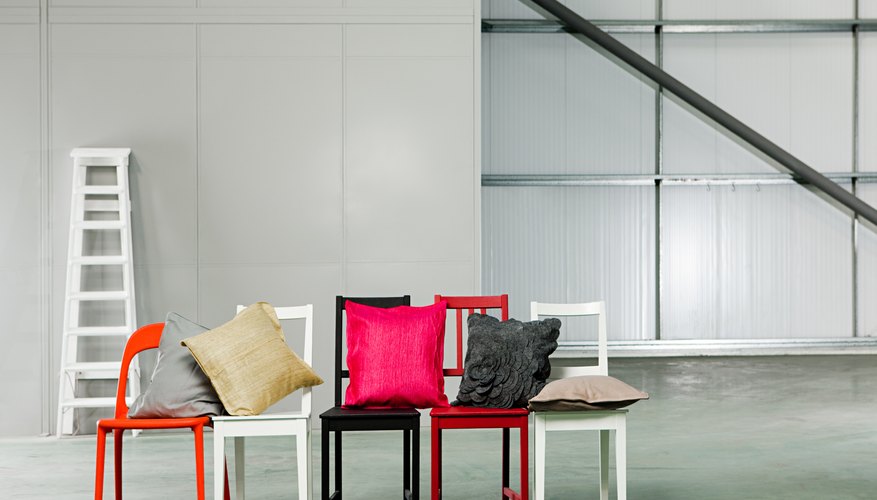Making new upholstered cushions for a set of dining room chairs, a side chair or almost any kind of simple wooden chair is easy with plywood, foam rubber and upholstery fabric. A staple gun and a little patience will enable almost anyone to do a professional-looking upholstery job. You can buy fabric and foam at any craft store, and plywood at a hardware store or building-supply house.
Plywood
Use plywood at least ½-inch thick; 3/4-inch plywood is even better. The plywood needs to be thick enough to support the weight of the person sitting in the chair. Cut the plywood to fit the seat frame of the chair. Many chairs frames have a recessed area for the chair cushion, so the plywood you cut must fit into this frame. Allow ½ inch of clearance on all sides to accommodate the batting and fabric you're going to wrap around the plywood to form your cushion. If you have an old cushion, you can use this for a pattern.
- Use plywood at least ½-inch thick; 3/4-inch plywood is even better.
- Many chairs frames have a recessed area for the chair cushion, so the plywood you cut must fit into this frame.
Foam
You can use any thickness of foam for your upholstery. Thicker foam will form a thicker cushion, so keep this in mind. You want to keep the foam in proportion to the size and style of your chair. One to two inches of foam are good choices for upholstery.
- You can use any thickness of foam for your upholstery.
Batting
In addition to the foam and plywood, you'll need a piece of quilt batting about four inches larger on all sides than your piece of plywood. Wrap this batting over the plywood and foam to provide extra cushioning and a smoother surface. You can use cotton or polyester batting of any thickness.
Other Tools and Materials
You'll also need a staple gun and scissors, plus upholstery fabric to cover the chair; upholstery fabric is thicker than dressmaking fabric, and will stand up better to the wear and tear of daily use. To figure out how much fabric you need, start with the size of your plywood, add the number of inches of thickness of your foam, and another three inches. If your plywood measures 20 inches by 22 inches and you are using two-inch foam, cut your fabric 25 by 27 inches.
Assembly
Lay your quilt batting on the floor or table. Center the piece of foam on the batting and top with your piece of plywood. Starting at one side, bring the edge of the quilt batting around and staple to the plywood in the centre of the fabric, near the edge of the plywood. Do the same with the other side, then the top and bottom. Then staple the corners, one at a time, gathering and tucking the quilt batting as needed to make it conform to the shape of the cushion. Don't use too many staples. Everything will be held together by the upholstery fabric. Your purpose now is to hold the foam to the plywood and smooth out any rough edges. Trim away any excess batting.
- Lay your quilt batting on the floor or table.
- Starting at one side, bring the edge of the quilt batting around and staple to the plywood in the centre of the fabric, near the edge of the plywood.
Lay out your fabric, wrong side up. Center your plywood and foam package on the fabric, with the plywood up. As you did for the batting, bring one edge of the upholstery fabric around to wrap your cushion. Turn under the edge of the fabric and staple in the centre. Repeat on each of the four sides of the cushion, turning under the edge of the fabric. Repeat for the corners. Now begin working your way around the cushion, pulling the fabric taut, folding under the edges and stapling as you go. Use as many staples as you need to hold the fabric in place; the staples will be hidden by the chair frame.
Finishing
Turn the cushion over. You should have a smooth, neatly upholstered cushion. Fit the cushion into the chair frame.
If you like, you can tack a scrim of black fabric to the underside of the chair to conceal the plywood and any staples that might show through. Use dark cotton cloth. Hem the edges on a sewing machine and use black upholstery tacks to attach the scrim to the wood.
- You should have a smooth, neatly upholstered cushion.
- If you like, you can tack a scrim of black fabric to the underside of the chair to conceal the plywood and any staples that might show through.
